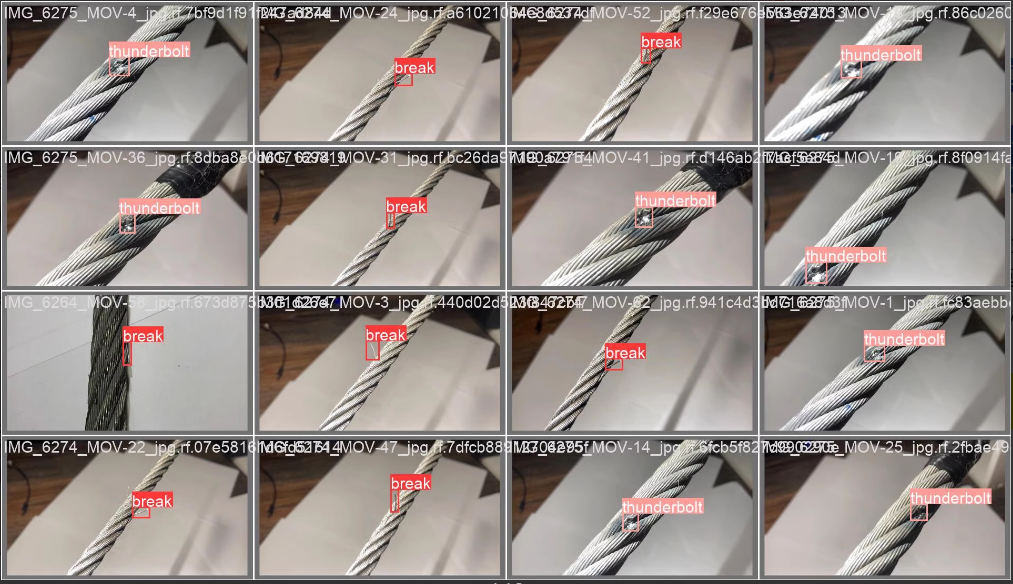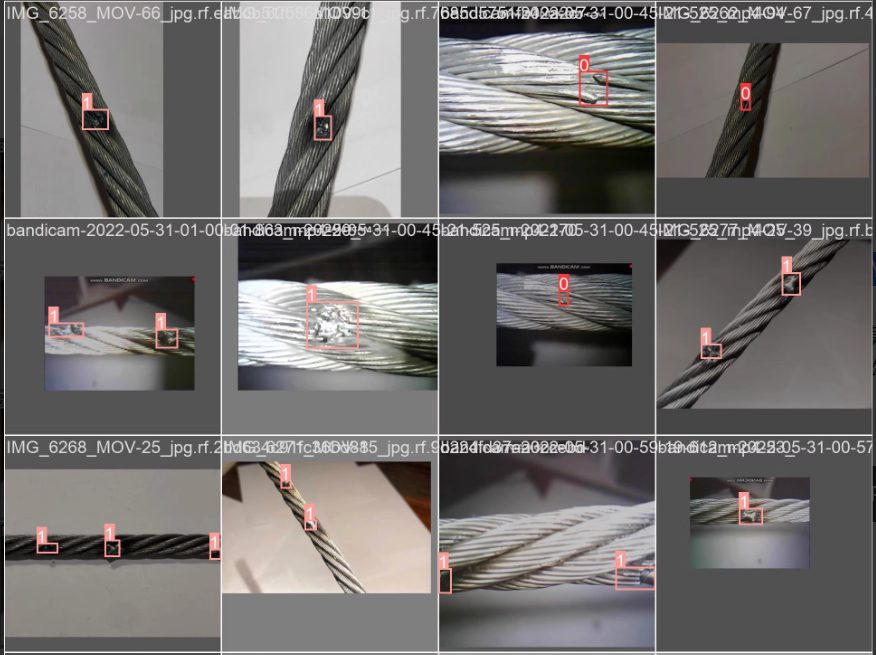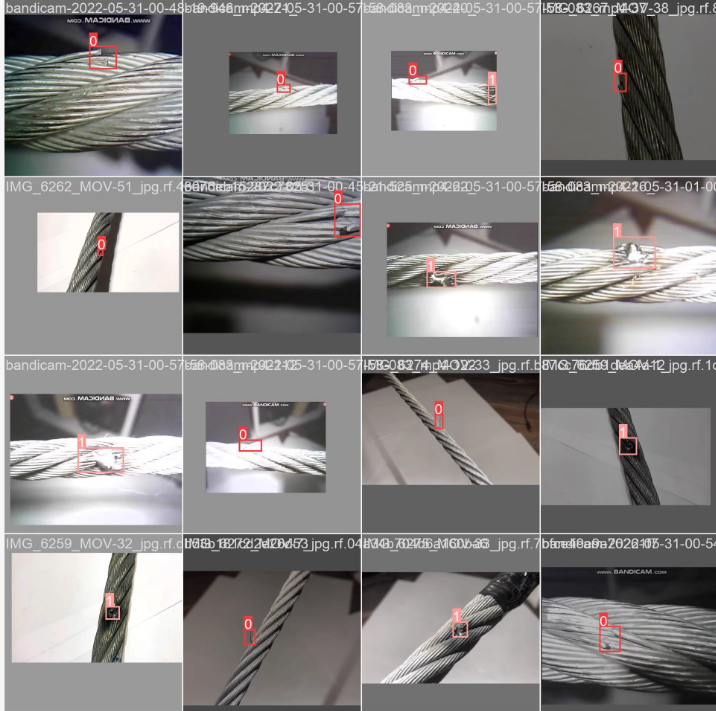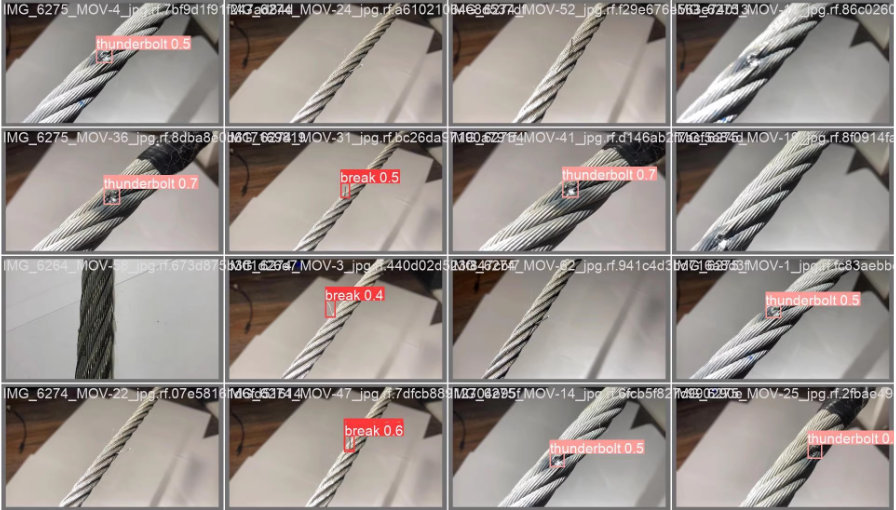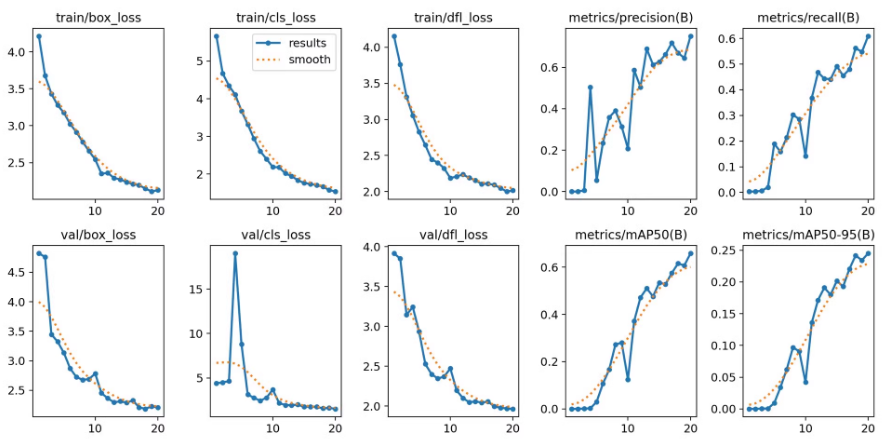工业钢缆缺陷目标检测数据集1000张2种 检测目标:破损+断丝带标注 -YOLO格式 可直接用于yolov5-v11
钢缆缺陷目标检测数据集
1000张
2两种检测目标:破损+断丝
带标注 -YOLO格式 可直接用于YOLO系列目标检测算法模型训练
钢缆缺陷目标检测数据集介绍
数据集名称
钢缆缺陷目标检测数据集 (Steel Cable Defect Detection Dataset)
数据集描述
本数据集旨在支持钢缆缺陷的目标检测任务,特别适用于工业安全检查、维护和故障诊断等领域。通过使用该数据集训练的目标检测模型可以帮助识别和定位钢缆中的破损和断丝缺陷,提高巡检效率和安全性。
数据量
- 总图片数: 1,000张
- 类别数: 2种
- 每张图片的标签数: 每张样本中至少包含一个或多个标签
检测目标
- 破损 (Damage)
- 断丝 (Broken Wire)
数据格式
- 图像格式: JPEG或PNG
- 标注格式: YOLO格式(每个图像对应一个文本文件,包含边界框坐标及类别标签)
目录结构
steel_cable_defect_dataset/
├── images/
│ ├── train/
│ │ ├── img1.jpg
│ │ ├── img2.jpg
│ │ └── ...
│ ├── val/
│ │ ├── img1001.jpg
│ │ ├── img1002.jpg
│ │ └── ...
├── labels/
│ ├── train/
│ │ ├── img1.txt
│ │ ├── img2.txt
│ │ └── ...
│ ├── val/
│ │ ├── img1001.txt
│ │ ├── img1002.txt
│ │ └── ...
└── data.yamldata.yaml 配置文件
train: ./steel_cable_defect_dataset/images/train
val: ./steel_cable_defect_dataset/images/val
nc: 2 # 类别数量
names: ['damage', 'broken_wire'] # 类别名称使用方法
1. 安装依赖库
确保安装了必要的Python库,如pandas(用于处理CSV文件)、torch(PyTorch)、ultralytics(用于YOLOv5/v7/v8)和其他相关依赖:
pip install pandas torch ultralytics2. 训练脚本
以下是一个简单的训练脚本示例,展示如何使用YOLOv5进行训练。
YOLOv5 训练脚本
from ultralytics import YOLO
import torch
# 设置设备
device = 'cuda' if torch.cuda.is_available() else 'cpu'
# 加载预训练模型或从头开始训练
model = YOLO('yolov5s.pt') # 使用预训练的YOLOv5s模型
# model = YOLO() # 从头开始训练
# 开始训练
results = model.train(
data='path/to/data.yaml', # 指定数据集配置文件路径
epochs=100, # 训练轮次
batch=16, # 批处理大小
imgsz=640, # 输入图像尺寸
workers=8, # 数据加载线程数
device=device, # 使用GPU设备编号,默认为0
project='steel_cable_defect_detection', # 保存结果的项目名称
name='exp', # 实验名称
exist_ok=True # 如果存在相同实验名,覆盖旧的结果
)
# 可视化训练结果
results.plot()
# 保存模型
model.save('steel_cable_defect_detection_model.pt')3. 推理代码
以下是一个简单的推理代码示例,展示如何使用训练好的YOLOv5模型进行推理。
YOLOv5 推理代码
import cv2
from ultralytics import YOLO
# 加载训练好的模型
model = YOLO('steel_cable_defect_detection_model.pt')
def detect_defects(image_path):
# 读取图像
image = cv2.imread(image_path)
# 进行推理
results = model(image)
# 绘制检测结果
for result in results:
boxes = result.boxes
for box in boxes:
x1, y1, x2, y2 = map(int, box.xyxy[0])
label = model.names[int(box.cls)]
confidence = float(box.conf)
color = (0, 255, 0) # 绿色
cv2.rectangle(image, (x1, y1), (x2, y2), color, 2)
cv2.putText(image, f'{label} {confidence:.2f}', (x1, y1 - 10), cv2.FONT_HERSHEY_SIMPLEX, 0.5, color, 2)
# 显示检测结果
cv2.imshow('Detection Result', image)
cv2.waitKey(0)
cv2.destroyAllWindows()
# 示例用法
image_path = 'path/to/your/image.jpg'
detect_defects(image_path)图形用户界面 (GUI) 设计
如果您希望提供一个更友好的用户界面,可以使用tkinter来创建一个简单的GUI。
1. 安装依赖库
确保安装了tkinter库,用于创建图形界面:
pip install tk2. GUI代码示例
以下是一个简单的Tkinter GUI示例,展示如何创建一个用户友好的图形界面,支持加载图像并进行目标检测。
import tkinter as tk
from tkinter import filedialog, messagebox
from PIL import Image, ImageTk
import cv2
from ultralytics import YOLO
# 加载训练好的模型
model = YOLO('steel_cable_defect_detection_model.pt')
def load_image():
global image_path
image_path = filedialog.askopenfilename(filetypes=[("Image files", "*.jpg;*.jpeg;*.png")])
if image_path:
image = Image.open(image_path)
image = image.resize((640, 480))
photo = ImageTk.PhotoImage(image)
image_label.config(image=photo)
image_label.image = photo
def detect_defects():
if image_path:
# 读取图像
image = cv2.imread(image_path)
image = cv2.cvtColor(image, cv2.COLOR_BGR2RGB)
# 进行推理
results = model(image)
# 绘制检测结果
for result in results:
boxes = result.boxes
for box in boxes:
x1, y1, x2, y2 = map(int, box.xyxy[0])
label = model.names[int(box.cls)]
confidence = float(box.conf)
color = (0, 255, 0) # 绿色
cv2.rectangle(image, (x1, y1), (x2, y2), color, 2)
cv2.putText(image, f'{label} {confidence:.2f}', (x1, y1 - 10), cv2.FONT_HERSHEY_SIMPLEX, 0.5, color, 2)
# 显示检测结果
image = Image.fromarray(cv2.cvtColor(image, cv2.COLOR_RGB2BGR))
image = image.resize((640, 480))
photo = ImageTk.PhotoImage(image)
image_label.config(image=photo)
image_label.image = photo
# 创建主窗口
root = tk.Tk()
root.title("Steel Cable Defect Detection")
# 自定义主题风格
root.tk_setPalette(background='#F0F0F0', foreground='black', activeBackground='blue', activeForeground="white")
# 图像显示区域
image_label = tk.Label(root, bg='#F0F0F0')
image_label.pack(pady=20)
# 按钮
load_button = tk.Button(root, text="Load Image", command=load_image, bg='blue', fg='white')
load_button.pack(side=tk.LEFT, padx=10)
detect_button = tk.Button(root, text="Detect Defects", command=detect_defects, bg='blue', fg='white')
detect_button.pack(side=tk.RIGHT, padx=10)
# 运行主循环
root.mainloop()总结
这个钢缆缺陷目标检测数据集包含了1,000张图片,每张图片中包含破损和断丝两种类型的缺陷标签。数据集提供了YOLO格式的标注文件,可以直接用于训练YOLO系列的目标检测模型。通过使用YOLOv5等目标检测算法,您可以轻松地进行模型训练和推理,并且可以通过图形用户界面方便地查看检测结果。
